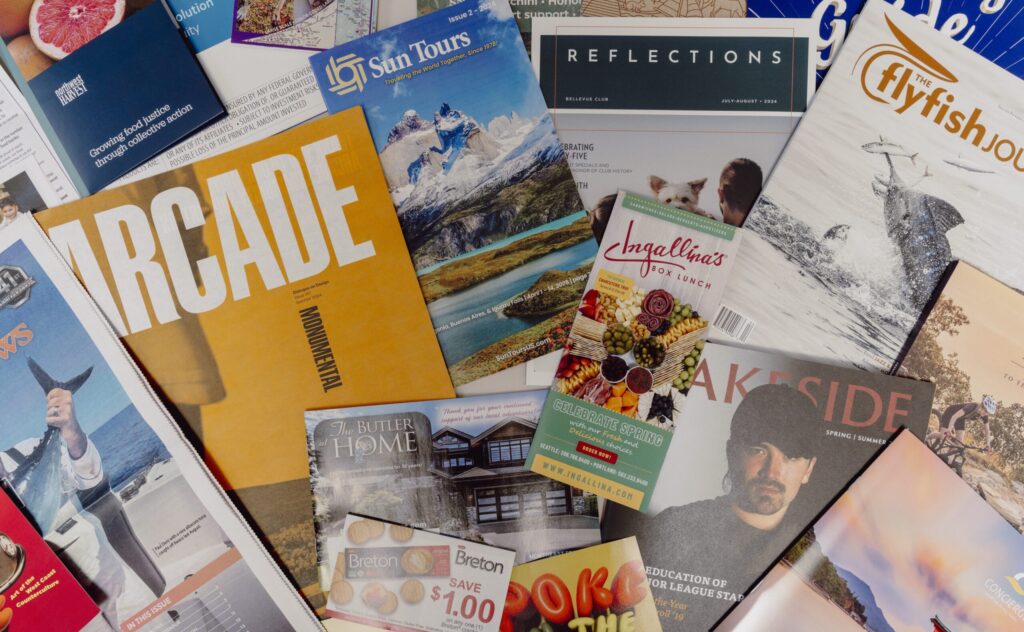Commercial printing is a vital part of your marketing strategy—but it doesn’t have to be the most expensive part. At Consolidated Press, we work with clients across industries to find cost-effective solutions that still deliver outstanding quality. Whether you’re printing brochures, books, magazines, direct mail, or catalogs, there are strategic ways to reduce your spend without sacrificing impact.
Here are 14 proven ways to lower your commercial printing costs while maintaining high standards:
1. Lower the Basis Weight of Your Paper Stock
The basis weight of your paper directly affects both your printing and mailing costs. Lighter-weight paper often performs just as well as heavier options and is ideal for projects like newsletters, catalogs, and direct mail. Choosing a slightly lighter stock can result in significant savings on postage—especially for bulk mailings—while also reducing material costs.
2. Use House Stocks Instead of Specifying a Brand
Many printers, including Consolidated Press, purchase house stocks in large quantities. These are high-quality, versatile paper stocks that perform well across many applications. By choosing a house stock instead of a specified brand, you gain the benefit of volume pricing and faster availability—usually with significant discounts.
3. Reduce the Size of Your Printed Piece
Designing a slightly smaller piece—such as trimming a brochure from 8.5″ x 11″ to 6″ x 10.5″—can reduce paper usage, minimize waste, and lower your postage rate. Even small adjustments to trim size can yield big savings across large print runs.
4. Choose CMYK Instead of Spot Colors, or Consider B&W
Four-color process (CMYK) printing is efficient and widely available. Spot (Pantone) colors, while useful for brand-critical projects, typically require additional press setups or inks and can drive up the cost. When high-end color is not essential—such as for internal reports or manuals — black-and-white printing is the most budget-friendly option.
5. Use Postcards or Self-Mailers Instead of Envelopes
When mailing, consider going envelope-free. Postcards and folded self-mailers cost less to produce and eliminate the need for inserting equipment and extra paper. They also tend to be more engaging—your audience sees your message immediately, without opening an envelope.
6. Gang Run Jobs to Save Setup Costs
If you’re planning multiple print pieces on similar paper stock—like a set of product sheets, postcards, or inserts—plan ahead and schedule them to run at the same time. “Gang runs” combine multiple jobs on a single press sheet, minimizing setup time and material waste. You’ll also see savings on binding and finishing, especially when pieces are similar in size or paper type.
7. Use PDF Proofs When Possible
Reviewing hard-copy proofs takes time, especially when shipping or delivery is involved. PDF proofs are a faster, more economical way to check layout, text, and color breaks. While press proofs are still valuable for color-critical jobs, most standard projects can be accurately reviewed digitally, saving both time and money.
8. Clean Up Your Mailing List
Every undeliverable mail piece wastes printing, postage, and time. Before sending your next mailing, run your list through a professional address hygiene service to remove duplicates, fix formatting errors, and eliminate bad addresses. Clean data means better ROI and less environmental waste.
9. Work with a Printer That Can Do It All In-House
When your printer handles all aspects of production—printing, binding, mailing, and fulfillment—in-house, you avoid expensive markups, coordination delays, and additional freight charges. Consolidated Press is fully equipped to manage projects from start to finish, ensuring better quality control and faster turnaround.
10. Schedule Projects in Advance to Avoid Rush Charges
Tight deadlines often require overtime labor, expedited shipping, or out-of-schedule press runs, which can all inflate your printing costs. Whenever possible, book your print jobs early. Not only will you avoid rush fees, but your printer will also have more flexibility to find cost-saving solutions.
11. Consider In-Line Glue Binding for Small Page Count Booklets
For booklets under 32 pages, in-line glue binding on a web press is a highly economical and efficient binding method. It’s perfect for manuals, inserts, small magazines, and newsletters where speed and simplicity are key.
12. Only Coat Where Necessary
While coatings like aqueous or UV can protect and enhance your print, they’re not always needed on every page. Limit coatings to high-touch areas like booklet covers or postcards, and leave interior pages uncoated to save on printing costs. It’s a smart balance between function and frugality.
13. Print on the Right Press for the Job
One of the biggest cost factors in printing is press choice. Offset printing is ideal for large runs with consistent quality, while digital printing is best for short runs, quick turnarounds, or jobs with variable data.
14. Work with Your Printer on Postal Discounts
The USPS offers discounts for direct mail based on format size, sustainability, integrated technology and more. If you send direct mail that is designed based on a USPS promotion, you can save big while trying out new engagement strategies.
Print Smarter, Not Smaller
Smart print planning starts long before your job hits the press. By working with a trusted commercial printer like Consolidated Press and following these strategies, you’ll stretch your budget further—without sacrificing visual impact or professional finish. We guide you to the right solution based on your quantity, quality, and turnaround needs.
Have a project in mind? Let’s talk. We’re happy to provide advice, quotes, and timelines to help you plan your next printing project wisely.
